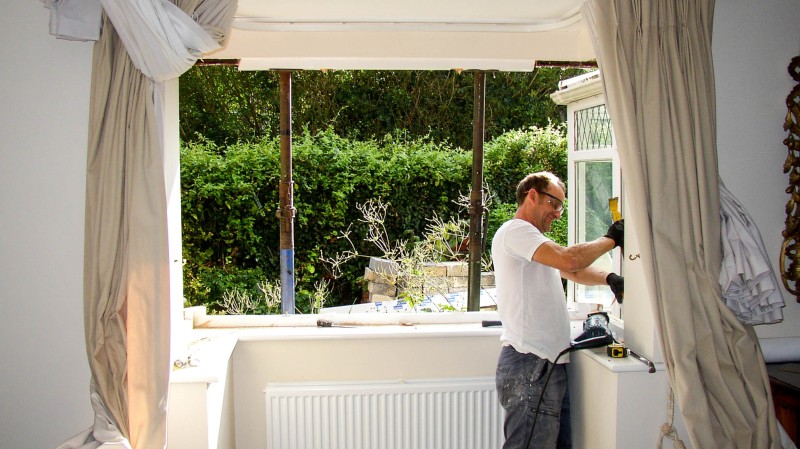You are here: How to save money on an extension
Building a new extension isn’t only for those with Grand Design budgets. Here are some top tips for keeping costs down.
Choose a simple design
If you’re on a tight budget build in a simple rectangular or square shape. It will work out cheaper than a more complex design. Avoid curved walls or frameless glass box extensions. Consider low-cost rooflights instead of dormer windows. Similarly, a flat or pitched roof will be cheaper than one with a valley or a hip detail.
Modest and pared back doesn’t mean you have to sacrifice style. Often the simplest solutions can be the most elegant. Invest in the structure – bricks and mortar and exterior finish of your extension to make the most of your budget. The interior décor can always be upgraded when you have more cash to splash.

Plan ahead
It’s much cheaper to make design changes at the beginning of a project rather than later. For instance, if you change your mind and want tiles instead of timber cladding on exterior walls. In the early concept stage this would just be a minor amend to update drawings, but if you decided to switch the cladding when building has begun, a new application to vary the planning application may be required, possibly delaying the build. The spacing of windows and other external elements may also need to be rethought and a variation of the construction contract agreed – all incurring extra costs.
Take time to think things through and visualise the end result. Plan the smallest of details from position of plug points to light fittings. This saves you having to make snap decisions and ensures that services, such as plumbing and wiring, are in the right place.
Build under permitted development rights
If your extension can be designed to fall within permitted development rights, it will save you time and money as planning permission won’t be required. This means you can avoid the planning fee of £206. What’s more you won’t have to pay an architect or surveyor to draw up plans and elevations to support a planning application. But if you want proof that your extension is allowed under permitted development and doesn’t require planning permission, you can apply through the Planning Portal for a Lawful Development Certificate (LDC). There is a fee.
Planning permission and Building Regulations
Find a local architect, architectural technician or chartered surveyor with a track record in designing low-cost projects. Some will produce planning and Building Regulations drawings for a fixed, all-inclusive price. While the cost of hiring design professionals can seem high, you’ll end up with a much nicer home extension. Plus, an experienced team can minimise expensive mistakes and the risk of costs spiralling out of control. An architect can administer the building contract and authorise paying the contractor in stages for work completed, for example.
Be your own building contractor
Each item in the main contract will be subject to the contractor’s overheads and profits. This can add up to 20% mark up on top of the cost of materials and labour. You can save money by ordering materials, skips and scaffolding yourself - though a builder may get better trade discounts. It’s important to get materials delivered at the right time, so goods are available for the relevant trades. Otherwise, there will be too much downtime on site.
Significant sums of money can also be saved by working as your own building contractor - hiring trades, running the site, liaising with the designer/architect and building control inspectors. But only manage your own build if you plenty of time and can be on site at least once every day. It helps to have some knowledge of construction too.
If you decide to hire a contractor, get a fixed total price – not a daily rate as this can be stretched out. The quote should include a breakdown of all the work to be done, materials needed and how long it’s valid for. There has been an explosion in the cost of materials in the past year.
Save on VAT
Check if your builder is VAT-registered. If so, they will charge you VAT at 20% on top of the cost of labour and materials. If you hire self-employed tradespeople who earn less than the VAT registration threshold (£85,000 in 2021), you won’t have to pay this this tax. Be aware some building work is charged at a reduced rate, for example, renovating or extending a home that have been empty for at least two years, adapting a building for a disabled person, installing insulation and air source heat pumps.
Investigate site and drains
A robust pre-build site investigation could literally save you thousands in the long run. From the results of this survey a foundation can be engineer designed that is the most economical for the site. If you are on a limited budget the last thing you need are nasty surprises once the building work has begun. Issues that would add costs to your build budget include re-routing pipes, drains, sewers or other buried services to fit your proposed layout. Digging trial holes and establishing drainage locations can keep costs down.
Limit the relocation of services
Adding an extra bathroom or moving your kitchen to a better location may be on your wish-list but there is always an associated cost. It can be more complicated than anticipated depending on the floor structure. If you are short of funds, limit the relocation of services, such as water pipes, soil pipe and drainage. When extending a house, positioning kitchen and bathroom fittings and fixtures in a convenient place to tap into existing services will help cut costs.
Avoid bespoke products & designer brands
Buying standard size doors and windows will help to conserve your cash. Bespoke and structural glazing, such as corner windows, have wow factor but don’t come cheap. Stick to off-the-shelf products. Designer kitchens can cost a small fortune. More affordable DIY-store or builder merchant products can often do the job at a fraction of the cost. A great way to save money is to buy ex-display and used designer kitchens from websites including www.usedkitchencompany.com and www.usedkitchenexchange.co.uk at up to 70% off the original cost. Black Friday deals and January sales can net you a bargain buy.
Reuse, recycle and repair
Look for ways to re-use or recycle existing materials. When a wall is demolished, bricks don’t need to be thrown on the tip but can be reused or recycled. Using salvaged materials is not only a great way to save money but greener too. They can be crushed and re-used on site for hardcore under patios and paving, for example. Existing timber floors can be sanded, oiled and re-laid. Buying salvaged materials from scrap yards or on the internet is a lot cheaper than buying new. For instance, roof tiles, internal doors, timber floorboards fireplaces and rolltop baths. Re-using materials, such as handmade bricks, can introduce instant character.
Build over the garage instead
Adding a room over an attached garage is usually a more wallet-friendly option than building a new extension – and you won’t be losing precious garden space. Ask a structural engineer to check if your existing foundations can take the extra load or will need to be strengthened (which will bump up the bill).
From planning ahead to finding a building professional with experience of low-cost extensions and avoiding bespoke products, there are multiple ways to cut the costs of building an extension.
If you are looking to make some home improvements, you may find some of these services useful
Building Regulations
Find details of local experts who can help with Building Regulations
Builders
Find local help with a building project
Architectural Design Services
Find local Architectural Design experts
Structural Inspections
Find an expert to carry out a structural inspection
Building Surveys
I want a local surveyor to do a Building Survey for me
Choose which Architectural service you require
If you are not sure which service you require, check out the options available...


